Abstract
Hyperbilirubinemia is frequently observed in neonates, and serious neurological complications such as kernicterus can be precipitated when the concentration of unconjugated bilirubin is abnormally increased. The administration of drugs which bind to albumin and compete with bilirubin can increase the possibility of such a complication. To test the bilirubin-displacing activity of pharmacological agents that are used with newborns, 52 antimicrobial agents were investigated in vitro. A glycine conjugate of salicylate, 2-hydroxybenzoylglycine, which is known to be present at elevated levels in newborns and has a potent bilirubin-displacing property, was used as a positive control agent. Pooled cord serum was used as a source of hyperbilirubinemic serum. A centrifugal ultrafiltration method with semipermeable cones was employed to determine the effects of potential bilirubin-displacing agents on the levels of total bilirubin. 2-Hydroxybenzoylglycine was demonstrated to be the most potent bilirubin-displacing agent. Antibiotics could be classified into four groups: high-level displacers (sulfisoxazole, sulfamethoxazole, dicloxacillin, cefoperazone, and ceftriaxone), intermediate-level displacers (moxalactam, nafcillin, and 14 others), low-level displacers (aztreonam, carbenicillin, and 11 others), and nondisplacers (mezlocillin, cefuroxime, kanamycin, and 15 others). It is concluded that the ultrafiltration method is a rapid and readily reproducible for the determination of bilirubin displacement and that antibiotics with a tendency to displace bilirubin should be avoided in jaundiced newborns whenever appropriate alternatives are available.
Full text
PDF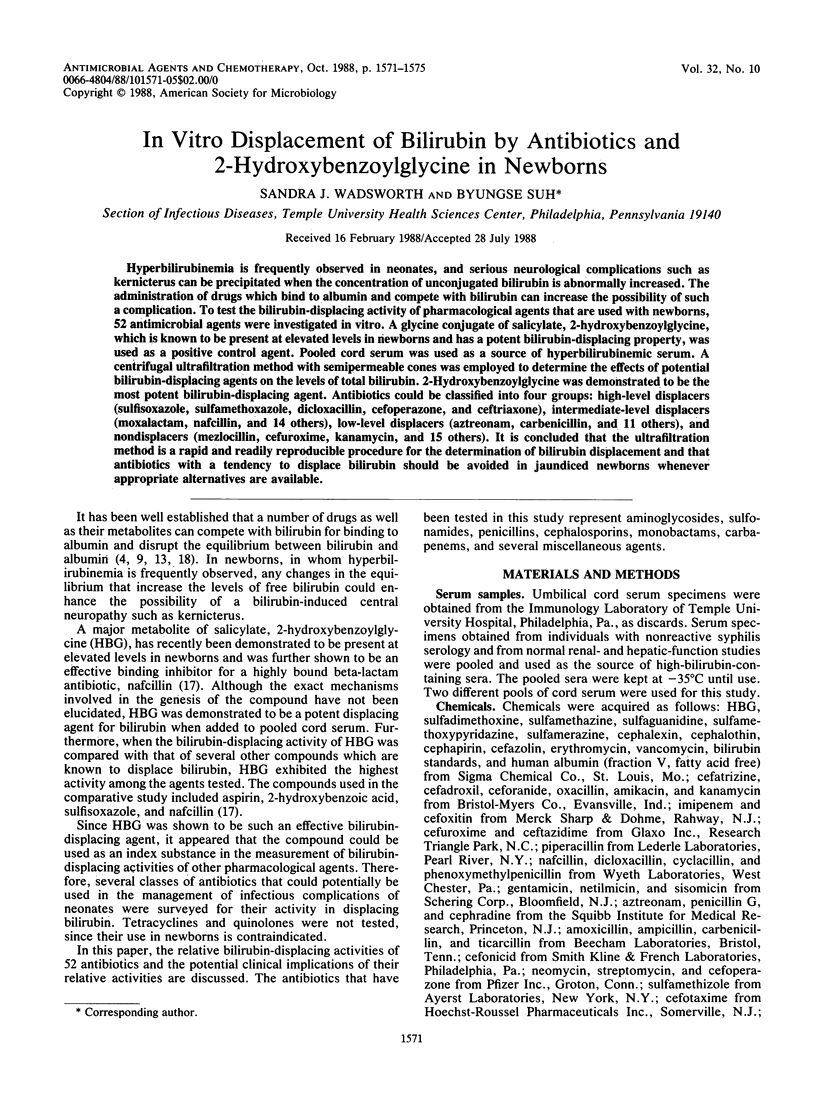
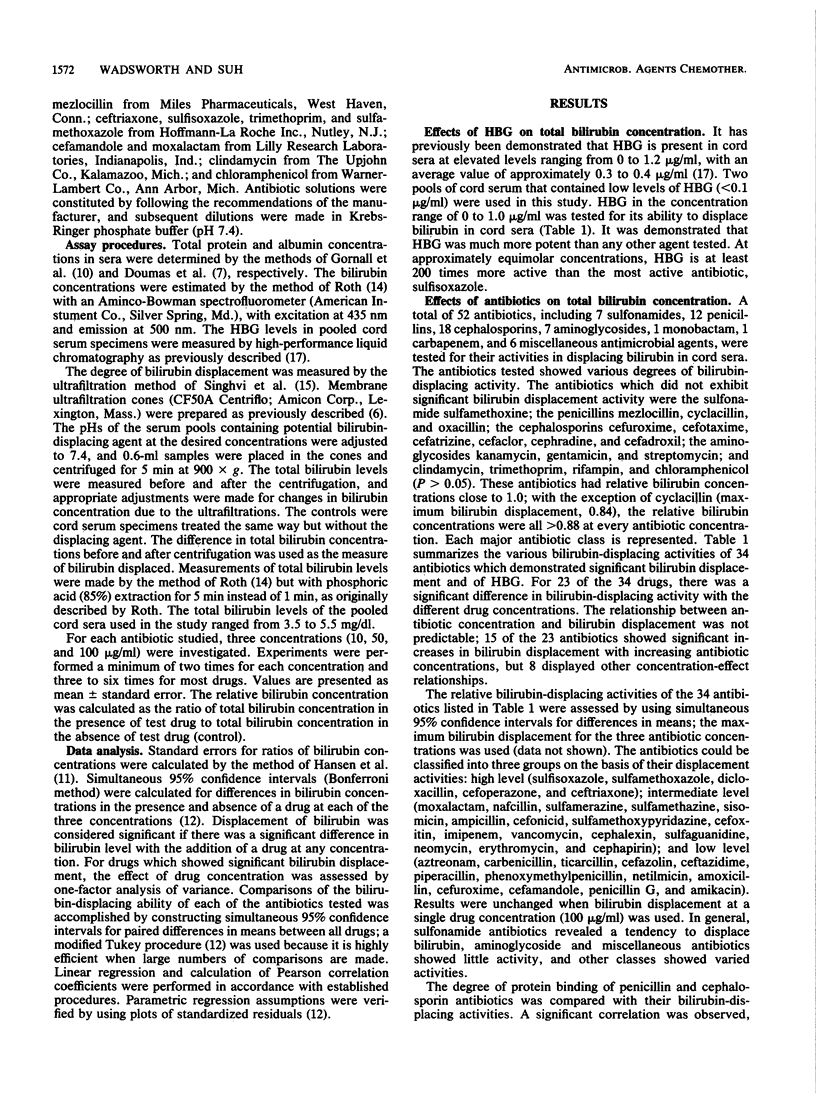
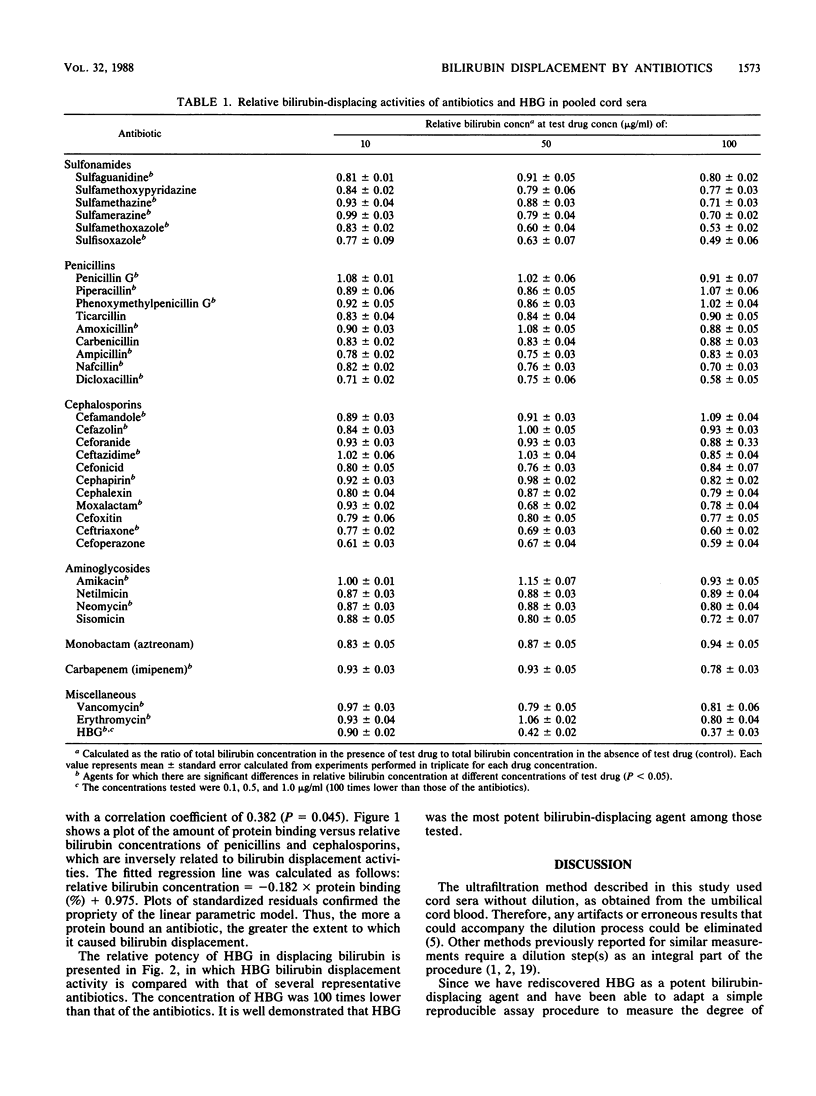
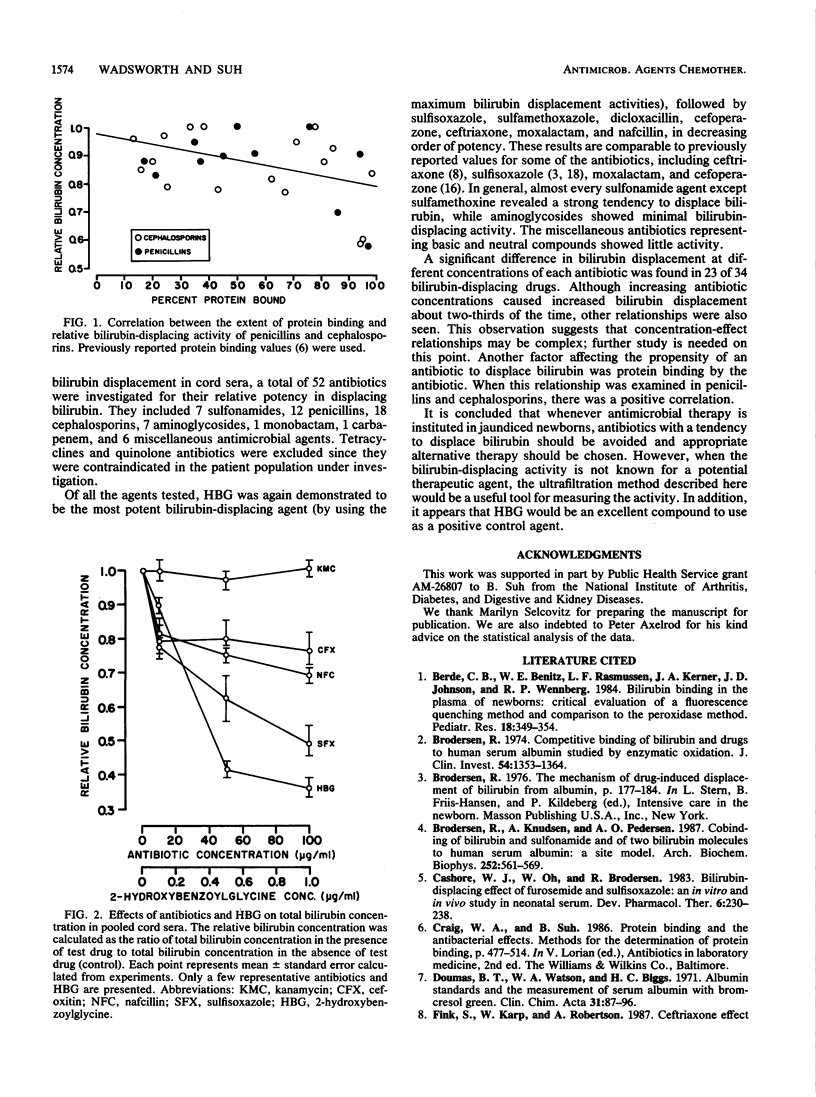
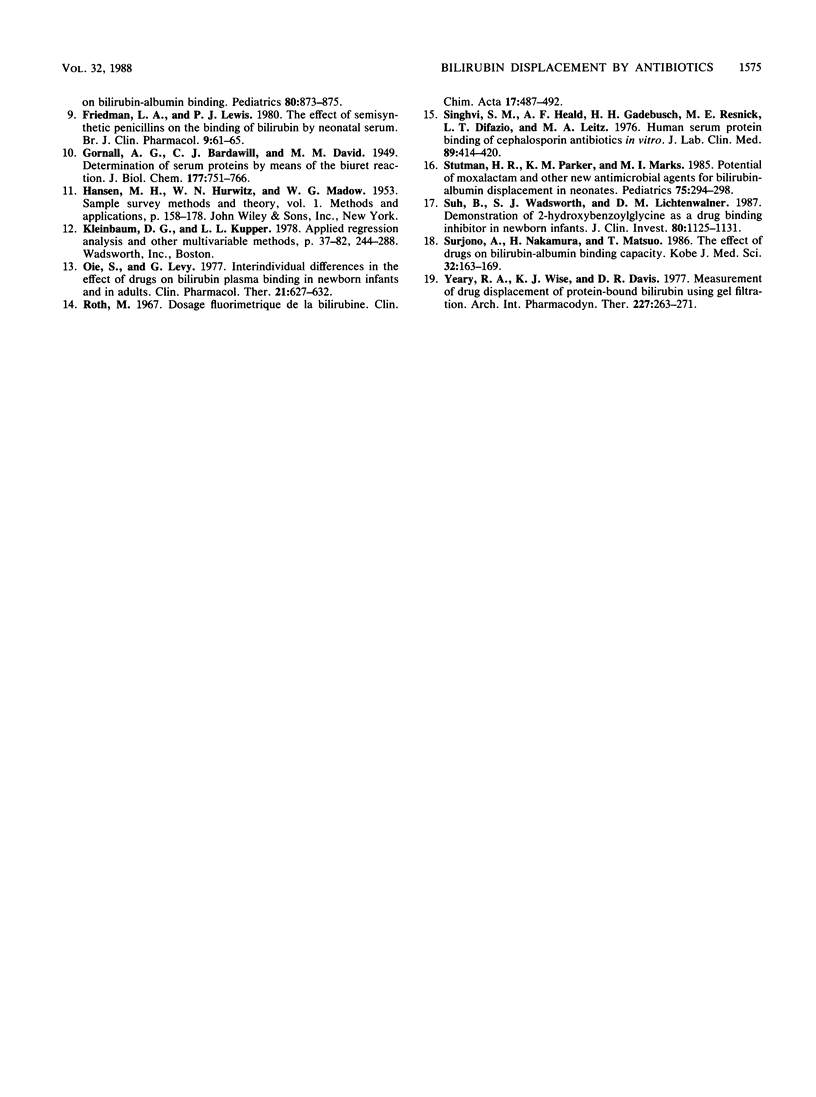
Selected References
These references are in PubMed. This may not be the complete list of references from this article.
- Berde C. B., Benitz W. E., Rasmussen L. F., Kerner J. A., Johnson J. D., Wennberg R. P. Bilirubin binding in the plasma of newborns: critical evaluation of a fluorescence quenching method and comparison to the peroxidase method. Pediatr Res. 1984 Apr;18(4):349–354. doi: 10.1203/00006450-198404000-00009. [DOI] [PubMed] [Google Scholar]
- Brodersen R. Competitive binding of bilirubin and drugs to human serum albumin studied by enzymatic oxidation. J Clin Invest. 1974 Dec;54(6):1353–1364. doi: 10.1172/JCI107882. [DOI] [PMC free article] [PubMed] [Google Scholar]
- Brodersen R., Knudsen A., Pedersen A. O. Cobinding of bilirubin and sulfonamide and of two bilirubin molecules to human serum albumin: a site model. Arch Biochem Biophys. 1987 Feb 1;252(2):561–569. doi: 10.1016/0003-9861(87)90063-4. [DOI] [PubMed] [Google Scholar]
- Cashore W. J., Oh W., Brodersen R. Bilirubin-displacing effect of furosemide and sulfisoxazole. An in vitro and in vivo study in neonatal serum. Dev Pharmacol Ther. 1983;6(4):230–238. doi: 10.1159/000457309. [DOI] [PubMed] [Google Scholar]
- Doumas B. T., Watson W. A., Biggs H. G. Albumin standards and the measurement of serum albumin with bromcresol green. Clin Chim Acta. 1971 Jan;31(1):87–96. doi: 10.1016/0009-8981(71)90365-2. [DOI] [PubMed] [Google Scholar]
- Fink S., Karp W., Robertson A. Ceftriaxone effect on bilirubin-albumin binding. Pediatrics. 1987 Dec;80(6):873–875. [PubMed] [Google Scholar]
- Friedman L. A., Lewis P. J. The effect of semisynthetic penicillins on the binding of bilirubin by neonatal serum. Br J Clin Pharmacol. 1980 Jan;9(1):61–65. doi: 10.1111/j.1365-2125.1980.tb04798.x. [DOI] [PMC free article] [PubMed] [Google Scholar]
- Oie S., Levy G. Interindividual differences in the effect of drugs on bilirubin plasma binding in newborn infants and in adults. Clin Pharmacol Ther. 1977 May;21(5):627–632. doi: 10.1002/cpt1977215627. [DOI] [PubMed] [Google Scholar]
- Roth M. Dosage fluorimétrique de la bilirubine. Clin Chim Acta. 1967 Sep;17(3):487–492. doi: 10.1016/0009-8981(67)90225-2. [DOI] [PubMed] [Google Scholar]
- Singhvi S. M., Heald A. F., Gadebusch H. H., Resnick M. E., Difazio L. T., Leitz M. A. Human serum protein binding of cephalosporin antibiotics in vitro. J Lab Clin Med. 1977 Feb;89(2):414–420. [PubMed] [Google Scholar]
- Stutman H. R., Parker K. M., Marks M. I. Potential of moxalactam and other new antimicrobial agents for bilirubin-albumin displacement in neonates. Pediatrics. 1985 Feb;75(2):294–298. [PubMed] [Google Scholar]
- Suh B., Wadsworth S. J., Lichtenwalner D. M. Demonstration of 2-hydroxybenzoylglycine as a drug binding inhibitor in newborn infants. J Clin Invest. 1987 Oct;80(4):1125–1131. doi: 10.1172/JCI113169. [DOI] [PMC free article] [PubMed] [Google Scholar]
- Surjono A., Nakamura H., Matsuo T. The effect of drugs on bilirubin-albumin binding capacity. Kobe J Med Sci. 1986 Oct;32(5):163–169. [PubMed] [Google Scholar]
- Yeary R. A., Wise K. J., Davis D. R. Measurement of drug displacement of protein-bound bilirubin using gel filtration. Arch Int Pharmacodyn Ther. 1977 Jun;227(2):263–271. [PubMed] [Google Scholar]


